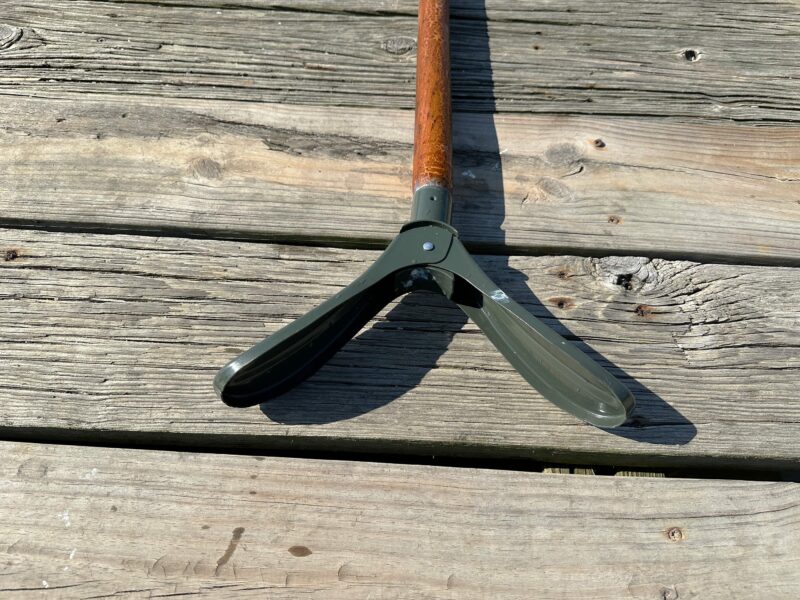For a decade, Audrey and I had a waterfront home in the northwest corner of Florida, east of Pensacola, on the shore of the shallow East Bay. As we explored the edges of those waters from 2011 to 2021, a push pole could take us through shallows and reeds that we’d avoid if we were paddling or rowing.
The push poles used in the mudflats and marshes in the East Bay area have lengths ranging from 12′ to 18′. There are many different attachments for the bottom end of the pole, and they play an important role. They should provide enough foundation for the pole to push against without sinking too deep into the muck. We tried a few different attachments while in Florida and they performed marginally well. On a few occasions we glided quietly away from our pole after I couldn’t pull it from the soft bottom in time to keep from going overboard with it.
 Photographs by the authors
Photographs by the authorsWhen force is applied to the push pole the Duckbill Head opens up to a 12″ span to increase the area pressing against the mud.
When we relocated to Virginia, we came across the Duckbill Head from H&H Outdoors, a company that specializes in gear for duck hunters and marsh fishermen. We ordered one and received the attachment promptly.
The Duckbill Head attachment measures 10 1⁄2″ long when folded, 4 1⁄4″ wide, and the widest part of the flared bill measures 2 3⁄4″ across. The bills have 3⁄8″-wide flanges around the edges and are hinged so they can open and close. When the powder-coated aluminum bills are opened, they span 12″.

When pulled, the Duckbill closes to make it easier to pull free from a sticky bottom.
The Duckbill can be attached to any 1 1⁄8″-diameter handle, wood or metal. The socket has a countersunk hole for a screw to secure the pole. Our wooden pole had a slightly undersized end, so we glued-on the new Duckbill with thickened epoxy.
We knew just by looking at the Duckbill that it would spread the pushing force across a wide area, and that the hinged mechanism would allow the device to be pulled easily from a soft bottom. And the attachment did, indeed, work quite well in our new local waters, which are bordered by marsh in many areas, especially around launch ramps, where the reeds interfere with oars. It has also been handy in shoal waters, where we have only a few inches to spare beneath the 8″ draft of our boats when it is impossible to lower a rudder, centerboard, or motor.

In mud, the duckbill attachment has a distinct advantage over fixed push pole heads: it won’t sink as deep or resist being pulled out.
With the Duckbill, we can exert as much force as we like without getting the pole stuck in the muck. In our new waters we have about a 4′ tidal range, and at low tide many areas are accessible only with a push pole.![]()
Audrey and Kent Lewis frequent the coastal marshes of the Middle Atlantic states. Their adventures are logged at Small Boat Restoration.
The Duckbill Head Attachment is available from H&H Outdoors for $24.50.
Is there a product that might be useful for boatbuilding, cruising, or shore-side camping that you’d like us to review? Please email your suggestions.












An interesting adaption. Without any knowledge of poling, it does seem as if the stiffening edges on the bills would be better the other side of the bills.
Am I missing something?
On the other side they could act as scoops for bottom material, harder to pull the foot out.
This style was first made by/for Herter’s – of Waseca, Minnesota – about 75 years ago. The design has stood the test of time. I have used them – primarily for duck hunting with an 11′ pole – but they are also handy on shorter poles in a canoe that ventures into swamps and beaver ponds – and also as and aid in wading in such habitats. Here’s an image of a catalog page from 1950. Rich-Mar made them next – and now others.
I concur that the lips on the upper edges would both grab bottom sediments and weeds as well as creating drag when pulled upward. It’s a wonderful tool as is.
Traditionally push-pole feet came in many types depending on the bottom. Some were set up so the pole could be used as a paddle if hitting deep water, others metal for working rocks. Mine is Delaware style with three natural crooks making three toed crows feet. They were mostly working in the marsh, reeds with a firm bottom. I learned to give the pole a little twist which help free it when the bottom was soft. I can use mine as a sprit sailing. Pole itself is a closet pole.